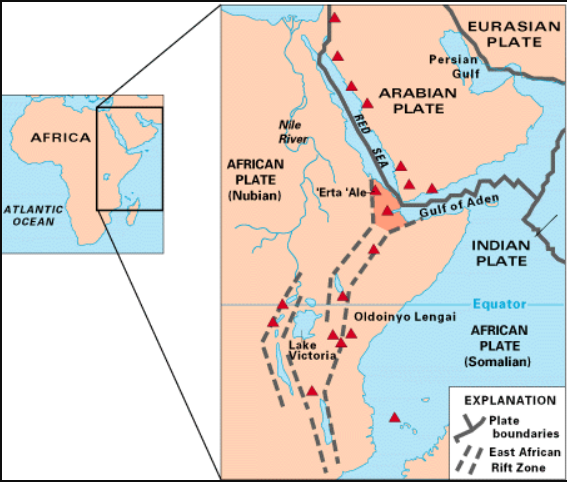Africa is slowly but surely splitting in two. The east of the continent is scarred by one of the largest rifts in the world. Despite its colossal size, scientists know surprisingly little about the complex movement of this unusual deformation. In a new study, researchers used GPS mapping and computer models to change that.
The feature in question is the East African Rift System (EARS), an active continental rift zone that stretches downward for thousands of kilometers from roughly north to south through Ethiopia, Kenya, the Democratic Republic of the Congo, Uganda, Rwanda, Burundi, Zambia, Tanzania, Malawi, and Mozambique.
The EARS is effectively a crack in the African plate that could split the continent into two plates – the smaller Somalian plate and the larger Nubian plate.
The two sides are drifting apart from each other at a super-sluggish snail’s pace of millimeters per year, less than the rate your fingernails grow. At this rate, it won’t be for millions and millions of years until the potential break-up occurs.
That said, we’re already witnessing the impact of the EARS since it’s seismically active. At points where the lithosphere is stretched especially thin, giant cracks in the ground can form and earthquakes are frequently sparked.
When we stand on Earth’s surface, it can feel rock solid. When viewed from afar on a vast timescale, it actually behaves much more like Silly Putty.
“If you hit Silly Putty with a hammer, it can actually crack and break,” D. Sarah Stamps, associate professor in the Department of Geosciences, part of the Virginia Tech College of Science, explained in a statement. “But if you slowly pull it apart, the Silly Putty stretches. So on different time scales, Earth’s lithosphere behaves in different ways.”

Map of East Africa showing some of the historically active volcanoes (red triangles), as well the two parts of the African Plate (the Nubian and the Somalian) splitting along the East African Rift Zone.
Image credit: USGS
There are two leading theories about how the EARS moves around. As per the first theory, it’s explained by something called lithospheric buoyancy forces, which are relatively shallow forces attributed mainly to the rift system’s surface and variations in the lithosphere’s density. The second theory involves much deeper forces, namely how Earth’s mantle flows horizontally deep beneath East Africa.
Stamps, along with her colleagues, have recently studied the EARS using computer modeling and GPS satellite data to map the movement of the surface with millimeter precision.
Their findings suggest that EARS is being driven by both the shallow lithosphere forces and the deeper mantle forces, but in very different ways.
The lithospheric buoyancy forces contribute to the rift spreading from east to west, running perpendicular to the direction of the fracture.
However, forces are also acting on the crack in a parallel direction – north-to-south – thanks to the African Superplume, a feature deep deep beneath southwest Africa that brings a stream of mantle material from the core–mantle boundary. It flows in a northeast direction across the continent, becoming more shallow as it extends northward.
In other words, part of the movement behind the vertical crack across East Africa is northward flow of mantle material deep below the surface, while it’s being split open from east to west by forces within its lithosphere.
“We are saying that the mantle flow is not driving the east-west, rift-perpendicular direction of some of the deformations, but that it may be causing the anomalous northward deformation parallel to the rift. We confirmed previous ideas that lithospheric buoyancy forces are driving the rift, but we’re bringing new insight that anomalous deformation can happen in East Africa,” explained Tahiry Rajaonarison, a postdoctoral researcher at New Mexico Tech.
The study was published in the Journal of Geophysical Research: Solid Earth in March 2023.
Source Link: Africa Is Splitting Into Two And New Data Is Uncovering How